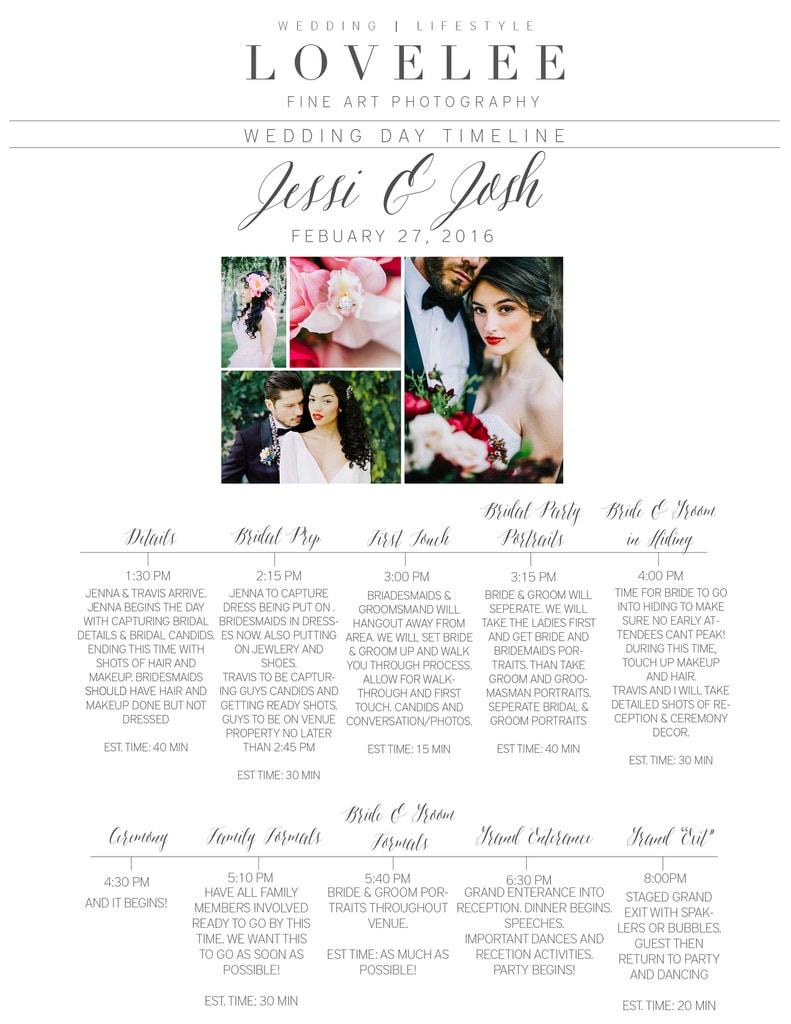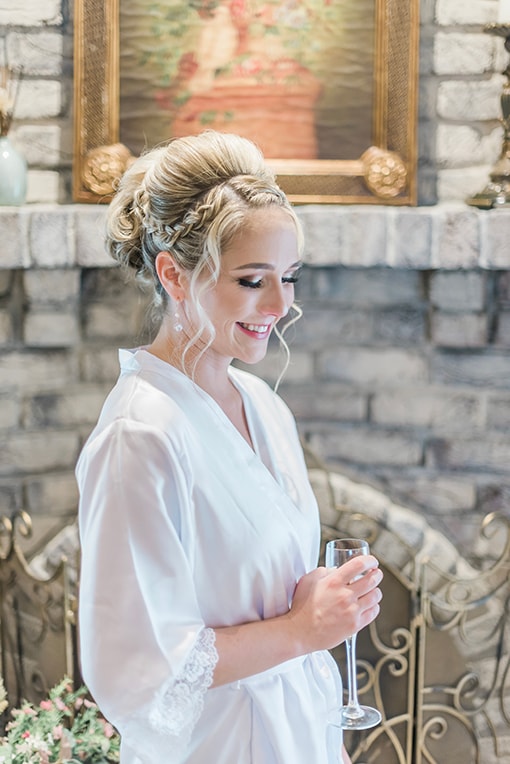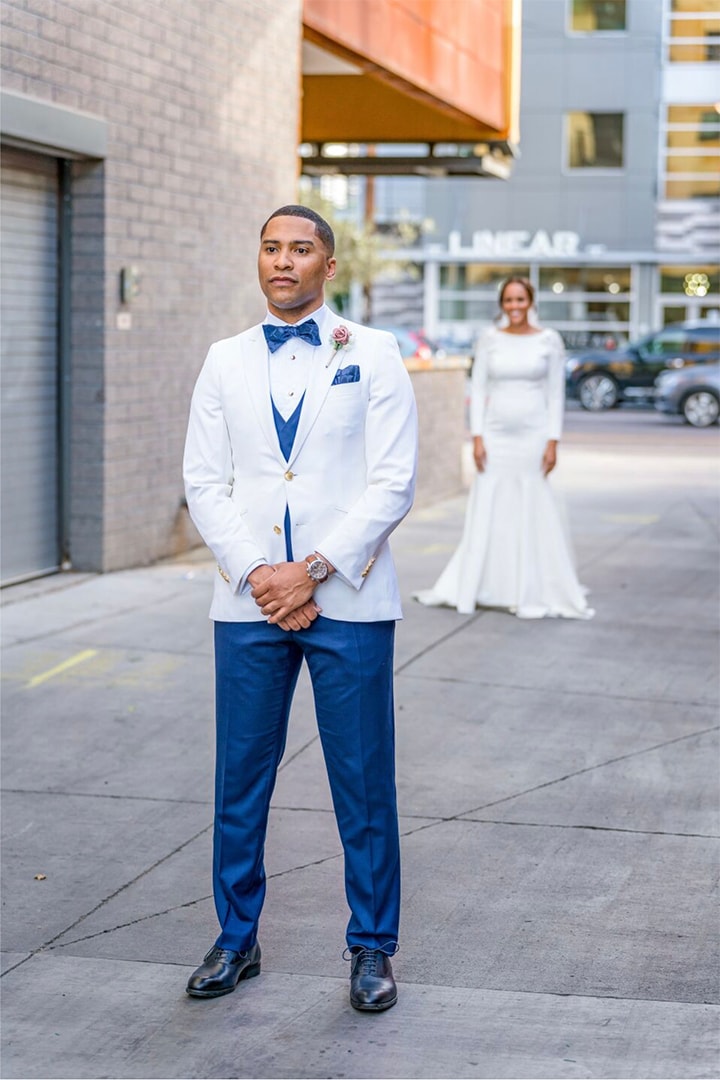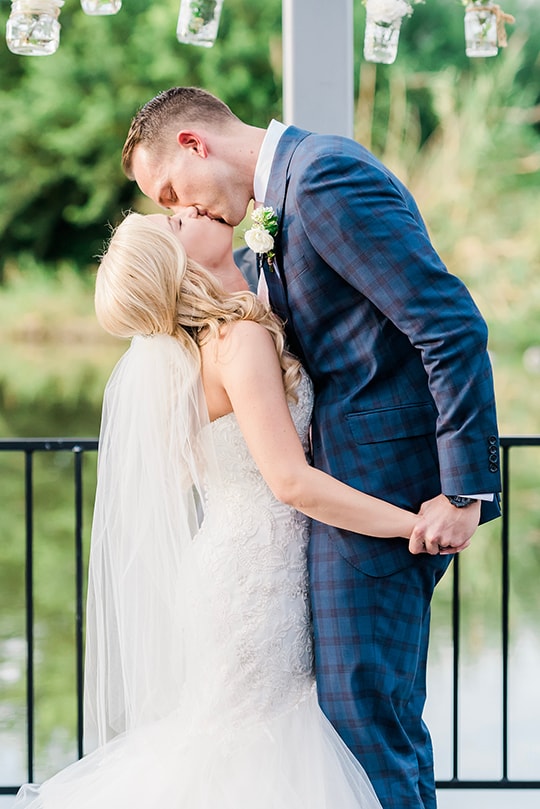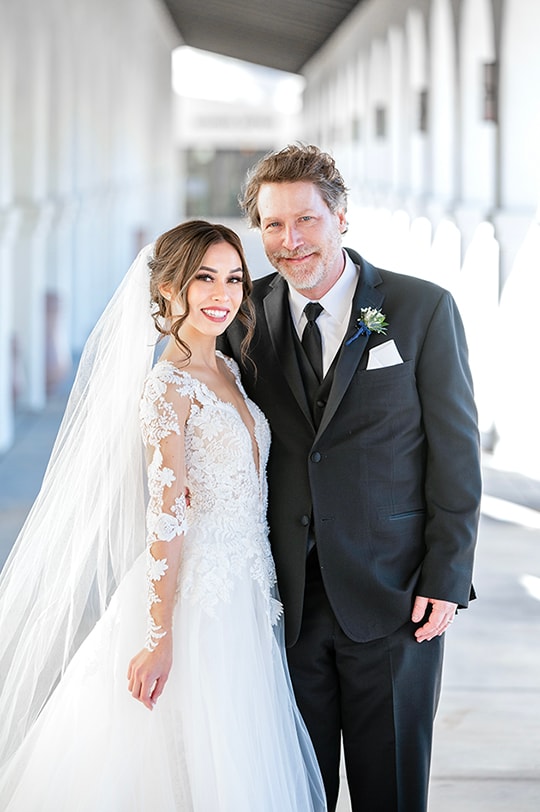Top Tips for a Relaxed Timeline on Your Wedding Day
Creating a relaxed event timeline reduces stress and ensures a smooth day. In this article, you’ll find tips for a relaxed timeline that help you enjoy every moment without feeling rushed. Learn how to start early, include buffer time, and prioritize key moments for a seamless experience.
Key Takeaways
-
Create a detailed yet flexible wedding timeline to ensure a relaxed and enjoyable day without rushing through key moments.
-
Incorporate buffer time between events and schedule early preparations to accommodate any unforeseen delays and set a peaceful atmosphere.
-
Make use of golden hour for stunning couple portraits and sunset photos, capturing intimate moments that enhance the overall wedding experience.
Start with a Realistic Timeline
Creating a wedding timeline helps avoid stress and ensures a smooth day. A well-structured schedule allows everyone to enjoy the celebration without feeling rushed. Prioritizing key moments and including buffer time helps create a more relaxed atmosphere.
A sample timeline can help visualize how the day will unfold and communicate plans with your vendors, ensuring everyone is on the same page. Remember, a realistic timeline allows each moment the time it deserves, rather than cramming too much into the day.
Begin Early
Starting preparations early helps create a relaxed atmosphere and ensures everything is completed on time. Begin with essential tasks like hair and makeup, allowing extra time for potential delays. This early start sets a calm tone for the day, providing peace of mind.
Planning a first look can also enhance the timeline. By scheduling this intimate moment before the ceremony, you can capture genuine emotions without the pressure of an audience. This not only helps calm pre-ceremony jitters but also maximizes your photography time by daylight.
Include Buffer Time
Incorporating buffer time between events is a lifesaver. This extra time helps accommodate any unforeseen delays, keeping the schedule flexible and stress-free. For instance, if the hair and makeup session takes longer than expected, the buffer time prevents the delay from cascading into the rest of the schedule.
A well-placed buffer can mean the difference between a rushed day and a relaxed, enjoyable celebration.
Prioritize Key Moments
Focusing on key moments like family photos is crucial to a relaxed wedding day. By prioritizing these significant events, you ensure that they are captured without stress.
Create a list of essential shots, such as immediate family and grandparents, to keep the session focused and efficient. Using a sample timeline can help visualize and prioritize these moments, ensuring they fit seamlessly into the day’s schedule. Phoenix wedding photographers often recommend these strategies for a seamless experience.
Getting Ready
The getting ready phase is an exciting part of the wedding day, filled with anticipation and emotion. Starting preparations early ensures there is ample time for capturing memorable moments. Brides should allow at least an hour for hair and makeup, or even two to three hours, to account for any unexpected delays. This relaxed start helps ease into the day, making everyone feel more comfortable and less rushed.
It’s also essential to ensure everyone involved knows the schedule to stay on track during this phase. Capturing candid emotions and details during preparations enriches the overall wedding photography, adding depth and a personal touch to the photos.
Hair and Makeup
Allocating enough time for hair and makeup is vital for a stress-free experience. Having a designated bridesmaid as a ‘personal assistant’ can help streamline communication and reduce stress during preparations. Limiting the number of people present during this time can also create a more relaxed atmosphere for the bride.
Having a wedding photographer present during the getting ready stage helps document spontaneous interactions among family and friends. This is an excellent opportunity to capture candid moments that add a personal touch to the wedding photos. Ensuring adequate time is allocated for hair and makeup also allows for touch-ups and unexpected delays, making it essential to consider the role of wedding photographers.
Candid Moments
Candid moments during preparations add depth and emotion to wedding photos. Bridal party and family interactions during hair and makeup offer excellent opportunities for candid shots. These spontaneous moments often become some of the most cherished photographs of the wedding day.
Ensure everyone knows the schedule so that there’s ample time for spontaneous moments before the ceremony begins. These moments, whether it’s a shared laugh or an emotional hug, enrich the storytelling aspect of your wedding photography and create lasting memories. Phoenix wedding photographers excel at capturing these candid interactions.
First Look
The first look is a magical moment that allows couples to see each other before the ceremony begins. This private time together can ease pre-ceremony jitters and foster a deeper emotional connection. Without the pressure of an audience, couples can express their genuine emotions, making this moment truly special.
Additionally, scheduling a first look maximizes the use of daylight for photography. The ideal time is 60-90 minutes before the ceremony, past noon, in a secluded area near the wedding venue. This approach not only enhances the emotional experience but also provides ample time for capturing stunning portraits.
Emotional Connection
The intimacy of a first look fosters a deeper emotional bond between the couple before the ceremony. This private moment lets them connect emotionally, share their excitement, and calm their nerves before the wedding festivities. This emotional connection is often beautifully captured in photographs, adding a personal touch to their love story and intimate weddings.
Photo Opportunities
A first look provides numerous photo opportunities in optimal lighting conditions. Scheduling your ceremony during golden hour, closer to sunset, can enhance the lighting quality for photography, especially if held outdoors. Planning for backlighting during the ceremony can help avoid harsh glare and make for more visually appealing photos.
Using natural light diffusers, such as trees, can create evenly lit conditions, enhancing the overall atmosphere of the ceremony. By employing these optimal lighting strategies, couples can achieve earlier formal photos, freeing up more time later in the day for relaxed portraits.
Ceremony Timing
Establishing a well-structured wedding timeline is crucial for managing expectations and reducing last-minute stress. A timeline ensures that all vendors are informed about their schedule, promoting a seamless wedding day. It also allows you to focus on significant moments, such as the ceremony, ensuring they receive the necessary attention and time for capturing these precious memories.
Allowing at least 45 minutes before sunset for the ceremony can enable time for photos in the golden hour light after the event. This ensures you get the best lighting for your wedding photos.
Planning the ceremony to finish before dark is crucial if the cocktail hour is intended to be outdoors, ensuring a pleasant environment for guests. A well-structured timeline is vital for coordinating the wedding day events, especially for the transition from the ceremony to the reception.
Optimal Lighting
Scheduling the ceremony to maximize natural light can provide stunning results for wedding photography. For outdoor ceremonies, consider the sun’s position and potential glare. Choosing a picturesque backdrop enhances the visual quality of wedding portraits, making them more memorable.
Ceremonies held in darker indoor venues benefit from choosing locations with ample natural light and white walls to enhance the overall atmosphere. Selecting a location with beautiful natural light can significantly improve the outcomes of couple portraits.
Smooth Transitions
To ensure a smooth transition to cocktail hour or the reception, start the ceremony 2-3 hours before sunset. Avoid long breaks exceeding 1.5 hours to maintain the flow of the day, keeping guests engaged and the schedule on track.
Family Photos
Family photo sessions can be stressful, so having a structured plan helps alleviate pressure. Allocate 20-30 minutes for family photos to capture various combinations. Scheduling family and bridal party portraits right after the ceremony helps manage the overall wedding timeline effectively, allowing for a smoother transition to the cocktail hour.
Having an organized list of desired family photo combinations is essential to streamline the process and ensure no one is overlooked. Designate a specific location for family photos to avoid confusion and to ensure everyone knows where to gather.
Organized List
An organized list of family photo combinations streamlines the photography process. Designating a specific location for family photos avoids confusion and ensures everyone knows where to gather, making the process smoother and more efficient.
Efficient Setup
Selecting a nearby photo location significantly reduces travel time on your wedding day. Family photos should ideally be taken close to the ceremony site to maintain the wedding day schedule.
Minimizing travel time by selecting a nearby location for photo sessions can help keep everything on track.
Couple Portraits & Cocktail Hour
Focusing on significant events like the ceremony and couple portraits ensures they receive the necessary attention and time. Scheduling 60-90 minutes for both couple portraits and cocktail hour allows for a relaxed atmosphere where the couple can enjoy their time without feeling rushed. Completing most of the formal photos before the ceremony provides more leisure time during the cocktail hour.
Golden hour provides the best lighting for intimate portraits, typically occurring shortly before sunset. Discussing sunset timing with your photographer helps ensure you capture the warm glow in your images.
If the schedule conflicts with golden hour, stepping out for brief photos during dinner can enhance the experience while ensuring memorable captures.
Scenic Location
Selecting a beautiful location for couple portraits is essential for stunning wedding photos. A scenic and private area away from guests is recommended for capturing intimate moments.
The right awesome location significantly enhances the aesthetic appeal of wedding photography, making you a better photographer.
Enjoyment Time
Plan for couple portraits to take 30-45 minutes after family and bridal party photos. Photograph bridal party shots after family photos to capture important moments with friends. Set aside time during cocktail hour for the couple to unwind and enjoy the company of their guests.
Encourage the couple to relax and mingle during cocktail hour, creating a joyful and laid-back atmosphere before the reception. This time allows them to celebrate with loved ones, making lasting memories and setting a positive tone for the rest of the evening.
Reception Flow
To ensure a relaxed and enjoyable evening, outline the reception timeline, including key moments like speeches, dinner, and dances. Toasts are often scheduled before or after dinner with speeches from family and friends. The cake cutting usually takes place after dinner, signaling the transition to more informal activities like dancing.
Incorporating speeches between meal courses can maintain guest engagement and facilitate smoother dining. Strategically timing key moments like the first dance and cake cutting keeps the energy flowing.
Late-night snacks can revive energy during a long reception, providing a fun surprise for guests. A planned grand exit with elements like sparklers or confetti adds excitement and creates memorable photo opportunities.
Key Moments
The reception often begins with a grand entrance followed by the couple’s first dance. Welcome speeches or meal blessings typically occur after the first dance to engage guests before dinner starts. An outfit change by the couple may happen after the meal service, allowing for a more comfortable experience during dancing.
Family dances serve as a transition into open dancing, encouraging guests to join the couple on the dance floor. Cake cutting is traditionally scheduled later in the evening to maintain guest participation in the festivities. Late-night bites can be offered during the final hour to keep guests energized after hours of dancing.
Flexibility
Including spontaneous activities like a photo booth or wedding games can enhance guest interaction and fun. Allowing couples time to relax during cocktail hour contributes to a more enjoyable wedding experience.
Building flexibility into the reception schedule allows for spontaneous moments, enhancing the atmosphere.
Sneak Away for Sunset Photos
Plan for 10-15 minutes for sunset photos during the reception to capture the couple’s love and joy. Choose a beautiful location for sunset photos to enhance the overall aesthetic of the images. Understanding the sunset time is crucial for achieving optimal lighting for sunset photos.
Scheduling the ceremony outside of peak sun hours (10 a.m. – 3 p.m.) helps avoid harsh lighting. Choosing a ceremony time that aligns with sunset creates softer and more flattering light for photography.
Golden Hour
Golden hour shortly before sunset offers warm, soft light, creating a romantic ambiance for photos. Schedule your photos to take advantage of this time for breathtaking scenery and intimate moments.
Encourage the couple to take a quick 10-15 minute break from the reception for golden hour photos.
Quick Break
Taking a brief pause from the reception allows couples to capture intimate moments in beautiful sunset lighting. A quick break during the wedding can result in stunning sunset photos, enhancing the overall experience.
If the schedule doesn’t permit golden hour photos, consider stepping out of the reception during dinner. A quick 15-minute sunset shoot can still be arranged. A clear view of the horizon is essential for successful golden hour shots.
End-of-Night Shots
Scheduling a last dance creates an intimate moment for the couple, allowing them to cherish their time together as the reception winds down. A faux exit with the bridal party is an option if photography coverage ends before the real exit, allowing for a controlled environment for perfect shots.
Using a bubble machine provides a charming bubble exit without requiring guests to blow bubbles themselves.
Grand Exit
Plan for a grand exit photo opportunity, whether it’s sparklers, confetti, or another fun idea. Consider creative options for your grand exit to make it memorable. Capture the last dance and final moments of the night, wrapping up the wedding photography coverage beautifully.
Organize your grand exit timing and details to ensure a smooth conclusion to your wedding day.
Last Dance
Reserve time at the end of the night for final shots, capturing the couple’s exit and any remaining candid moments.
Plan for a grand exit photo opportunity, whether it’s sparklers, confetti, or another fun idea.
Summary
In conclusion, a well-organized wedding timeline is essential for a relaxed and enjoyable wedding day. Starting preparations early, including buffer time, and prioritizing key moments can make all the difference. Remember to capture candid moments during preparations, plan for a first look, and schedule your ceremony to take advantage of optimal lighting. Ensure smooth transitions between events, and take a quick break for sunset photos. Finally, end your night with a memorable grand exit and last dance. By following these tips, you can create a stress-free timeline that allows you to fully enjoy your special day. Phoenix wedding photographers can help guide you through this process with their expertise.
Frequently Asked Questions
Is $4000 a lot for a wedding photographer?
$4,000 is on the higher end of the average range for wedding photography, but it can be well worth it for capturing your special day beautifully. Investing in a skilled photographer can provide lasting memories that you’ll cherish forever!
Does a photographer help with a timeline?
Yes, a photographer is instrumental in helping create a timeline, ensuring you allocate the right amount of time for each shot throughout your wedding day. Trusting their expertise will make your day run smoothly and capture every precious moment beautifully!
What is the order of a wedding day?
The order of a wedding day typically starts with the bride’s mother, followed by the groom, best man, wedding party, flower girl, and ring bearer, with the bride, escorted by her father, being the last to walk down the aisle, creating a beautiful and memorable moment. Embrace the joy of each step!
Who comes up with the wedding timeline?
The wedding timeline is ideally crafted by a professional wedding planner, ensuring everything runs smoothly and fits your needs perfectly. Trusting their expertise will help you enjoy your special day stress-free!
Why is it important to start wedding preparations early?
Starting wedding preparations early creates a relaxed atmosphere and helps you avoid last-minute stress, allowing you to enjoy the process. You’ll have ample time to thoughtfully plan every detail, ensuring your big day is just as you envisioned!

